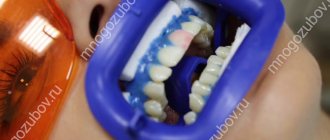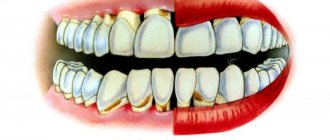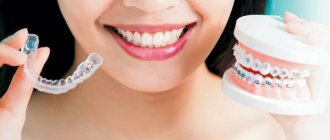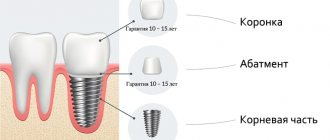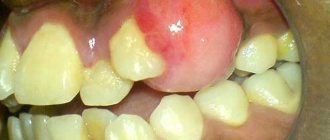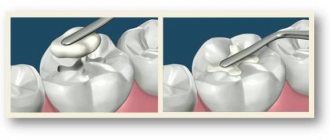1914
Primary teeth play an important role in the development of speech, proper bite, chewing function and jaw growth. And it is very important that they remain healthy until the changeover period.
Treatment of caries in young patients can be a real challenge for the doctor and parents.
Twinky Star is a unique dental material that can qualitatively replace the hard tissues of the temporary unit and engage the child in the treatment process.
General presentation and purpose
The German dental company VOCO GmbH The Dentalist has been producing dental materials since 1981. The company has gained worldwide success in the dental market thanks to its innovative and quality products.
Twinky Star is a filling material that combines COMPO Zit and glass and MER , called COMPOMER . It contains photopolymerizing resins and glass ionomer polymers , so the curing reaction takes place in two stages:
- Light (under the influence of a halogen or LED lamp).
- Acid-base (within two months the filling is saturated with moisture from the oral cavity and hardens, and its size also increases by 2%).
Organic microfiller in the form of fluorosilicate glass is capable of releasing fluoride ions into tooth tissue for 300 days. This gives the material an anti-caries effect and reduces the risk of developing secondary caries.
Due to its characteristics, the material can be used for filling both chewing, cutting and contact surfaces of the tooth.
Pros and cons of various filling materials
All fillings in dentistry are divided into 2 main groups: temporary and permanent. The first ones are installed during long-term therapy (treatment of pulpitis, periodontitis, cysts at the root apex). The second is to restore the crown part of the tooth. Their service life is from 2 to 10 years.
Additional Information! When using temporary compounds, doctors rarely ask the patient which fillings to choose. They are guided by medical indications. But the situation is different with permanent ones: not only the clinical picture is taken into account, but also the personal preferences and financial capabilities of the patient.
Plastic fillings are used as temporary fillings.
Several types of filling materials are used in dental practice.
Plastic
The main advantage is low cost and ease of use. They prefer not to use plastic compounds due to numerous disadvantages:
- unaesthetic: the material does not accurately restore the color and anatomical shape of the tooth, it quickly stains and darkens;
- low adhesion - grip;
- high shrinkage;
- toxicity - over 90% develop secondary caries, pulpitis;
- short service life - on average 2 years.
Metal
They are an alloy of a base metal (most often gold, silver), mercury and auxiliary components. Such fillings - amalgams - are super strong. The service life often exceeds 10 years. They are also cheap.
But amalgams are almost never used today due to:
- possible galvanism: changes in electrochemical processes in the oral cavity, accompanied by a metallic taste;
- low aesthetics: the color of the filling differs sharply from the enamel;
- differences in the coefficient of thermal expansion of the tooth and the composition - destruction of the walls is possible.
Amalgam lasts more than 10 years.
Cement
In domestic dentistry, the tooth crown was restored in most cases with cement compounds until the early 2000s. Today this filling material has not lost popularity due to:
- relatively low cost;
- sufficient strength - lasts 3 - 5 years;
- tight adhesion to the walls of the tooth;
- the presence of fluoride in the composition prevents further development of caries.
Important! Cement-based materials are preferred for the treatment of hard-to-reach units (“eights”) and primary teeth.
Cement fillings are often placed in figure eights.
The most common fillings are glass ionomer cement (GIC). It is as close as possible to the color of enamel, highly durable, non-toxic, and moisture resistant. There are also silicate and phosphate cement compositions. Their area of application is prosthetics. Materials are used to attach crowns.
Characteristics
Each dental material has its own physical and chemical properties. They determine how durable and strong the filling is in the tooth cavity. But you should not compare the parameters of different companies and materials, since all tests are carried out using different methods.
Main characteristics of Twinky Star:
| Characteristic | Parameter | Definition |
| bending resistance | 116 MPa | the level of resistance of the material to bending load and the ability to return to its original position; |
| fillers | 77,8% | the amount of inorganic filler in the form of particles of strontium fluorosilicate glass and strontium fluoride; |
| abrasion | 15.4 µm | resistance of the filling to abrasion under the influence of mechanical factors; |
| compressive strength | 316 MPa | under what chewing pressure will the filling be destroyed? |
| polishability | very good | depends on the particle size in the material. Less is better. Compomers have a micro size of 0.8-1 microns; |
| radiopacity | 220% AL | degree of visualization on an x-ray image. For comparison, Rg of enamel is -230%, dentin -150%; |
| dye fastness | high | over time, the color does not change, does not discolor, thanks to insoluble mineral substances - mica. |
The higher the filling percentage of the material, the lower the shrinkage rate, the higher the radiopacity, strength, durability and reliability.
In what cases is retrograde root canal filling justified?
Read here about Filtek filling material.
At this address https://zubovv.ru/lechenie/zubyi/plombyi/stekloionomernogo-tsementa.html we’ll talk about the pros and cons of glass ionomer cement for filling teeth.
Contents and release form
One Twinkie Star set consists of:
- 40 capsules of 0.25 grams of material (5 capsules per color);
- coloring system (with the help of which the child will choose the color he likes from the eight presented);
- dispenser caps (special applicator in the form of a gun for quick and convenient application of the material).
The Twinkie Star Flow (flowable composite) set includes two NDT syringe dispensers in blue and pink and disposable application cannulas.
Non-Dripping Technology (NDT) - an innovative dispenser developed by VOCO, allows you to economically and safely apply the material without leaking or dripping.
The filling set of capsules provides eight color schemes for future fillings:
- gold;
- silver;
- blue;
- green;
- pink;
- orange;
- yellow;
- blackberry
Advantages and disadvantages
VOCO's research and development is not limited to creating dental materials that are effective for patients.
Over the years, patented forms and systems have also been successfully developed for the quality, convenience and speed of the dentist's work.
Twinky Star has a number of advantages:
- the bright colors of the material will help the child push the feeling of fear into the background;
- quick filling process due to the capsule dispenser;
- presence of anticaries effect;
- it is possible not to use etching, thanks to the unique self-etching bonding from VOCO;
- high quality of the material due to physical and chemical parameters;
- the ability to treat complex clinical cases using a fluid form of the material;
- high biocompatibility with dental tissues.
The only disadvantage is the cost of treatment. Compared to cements or composites, the price will be higher.
What is the process of installing a filling?
What is the point of filling? The dentist will remove the damaged natural tissues of the baby tooth and replace them with artificial ones . Filling takes place in several stages:
- It is necessary to numb the area around the tooth that the dentist will fill. To do this, an anesthetic injection is given. And so that the child is not afraid of the injection, this area is first treated with an anesthetic drug.
- Then you need to clean the dental cavity from damaged tissues. This is done using a drill, laser or sandblasting tools.
- After this, the dentist checks the condition of the pulp. There are two options: disinfection, if there is no damage, and removal, if the pulp is inflamed.
- The doctor must make sure that the caries has been removed. The cavity must be cleaned of bacteria. Before applying the filling material, the nerve should be protected with a special gasket.
- The next stage is the filling itself. The material chosen for treatment is applied in layers. They are given hardness by special light. After installing the filling, the tooth needs to be polished and ground.
The process of installing a light seal
ATTENTION ! Are you unsure whether to treat a sick baby tooth or just remove it? Choose filling. You need to fight for every child’s tooth! Otherwise, their absence will lead to malocclusion, problems with speech, and improper growth of the main teeth.
Indications and contraindications
Colored fillings are used only in pediatric dentistry to fill any cavities in temporary teeth.
But it is not always possible to use Twinky Star material, as there are contraindications:
- intolerance to components;
- direct covering of the dental pulp;
- the presence of a heart rate stimulator (a photopolymer can disrupt the operation of the device);
- there is no way to isolate the tooth;
- combination with cements that contain zinc oxide and eugenol;
- occlusal load of permanent teeth.
Signs indicating the need for root canal filling and the drugs used.
In this article you will find reviews about the Spectrum filling.
Follow the link https://zubovv.ru/lechenie/zubyi/plombyi/harakteristika-tsementnoy.html if you are wondering how long a cement filling on a tooth will last.
Filling or silver plating
Silver ions stop the growth and division of pathogenic microorganisms. This means that caries will not develop in the future. But silvering is prescribed only in the initial stages of the disease. When large areas are damaged, it is useless to silver a baby tooth; over time, it will still collapse. A puncture may occur, which certainly will not be pleasant for the baby.
Is it possible to do a filling without a drill?
Today, medicine has made great progress and dentistry is no exception. Our clinic has ultra-modern equipment that does not produce frightening noisy sounds. In addition, filling is currently performed chemically. Its essence is the application of a special gel-like substance, which, after 30 minutes of exposure, is removed along with the damaged tissues. Then filling material is applied to this place.
Anesthesia
In order not to traumatize the psyche of children, dentists use injections extremely rarely. Pain-relieving gels and sprays are mainly used. Injection anesthesia is used only in extreme cases.
Anesthetics are selected in each individual case and are used only when there are no contraindications.
Causes of caries
- artificial feeding;
- genetic predisposition;
- poor nutrition (lack of sufficient fluoride in the diet),
- injuries;
- defects, features of the anatomical structure of bone tissue;
- poor oral hygiene;
If the development of the disease is associated with inheritance or poor health, it is necessary to regularly show the child to the pediatric dentist.
Preparatory actions
The stages of dental treatment begin with an examination and medical history. The child uses a special plate to choose the color of the future tooth.
Preparing and filling a tooth goes through the following stages:
- Insulation (use cotton rolls, cofferdam, rubber dam).
- Cleaning the surface from dental plaque (jet of water, hygienic cups).
- Gentle preparation, removal of necrotic tissue (it is important to preserve healthy tissue as much as possible).
- Antiseptic treatment (chlorhexidine, hydrogen peroxide).
- Flushing the cavity with a stream of water.
- Air jet drying.
- Applying a therapeutic pad based on calcium hydroxide (if the cavity is close to the pulp).
- Application of matrices, caps, wedges (to create contact points).
- Application of self-etch adhesive.
- Application of the material with photopolymerization of each layer.
- Checking contact points using copy paper.
- Grinding and polishing the filling surface.
- Coating the tooth with an insulating varnish that contains fluoride ions.
In pediatric dentistry, they are already abandoning the use of phosphoric acid for etching enamel. Innovative self-etch bonding systems provide a strong bond between tooth dentin and filling.
Twinky Star fillings work well with Futurabond from VOCO. Exposure time is only 25 seconds (5 for application, 10 seconds for drying and 10 for light activation).
What filling materials are used for baby teeth?
Treatment of baby teeth has its own characteristics. Thus, children are strictly prohibited from having amalgam or plastic fillings installed. Children's crowns are restored using three materials:
- Cement compositions. They prefer GIC. Particularly useful for progressive or recurrent caries and insufficient hygiene. Sometimes they note the fragility of the composition, but since the “milkmen” will be replaced in a couple of years, this factor does not play a role.
- Photocurable composites. They can be used only if a number of conditions are met: the absence of extensive carious damage, good hygiene, and high-quality cavity treatment. They prefer not to use them for the following reasons:
- it is difficult for the child to sit for a long time, he rarely allows the cavity to be fully cleaned and antiseptic treatment is carried out, as a result, the installation technology is disrupted, and the filling may fall out in a couple of weeks;
- in children, there are wide dentinal tubules through which the released residual monomer after polymerization penetrates to the pulp and has a toxic effect on it, the composite must be separated from the dentine with a special spacer;
- in “milk jugs” and permanent units, mineralization occurs several years after eruption; their density is lower than that of composites, due to which the walls of the tooth often break.
Children are strictly prohibited from having amalgam or plastic fillings.
3. Color compomer. These fillings are used most often due to:
- ease of operation: high plasticity, quick installation;
- the ability to accumulate fluoride from pastes and food, and then release it to tissues;
- good grip;
- safe chemical composition;
- the child can choose the color - this factor helps to establish contact with the doctor, children enjoy caring for multi-colored teeth;
- The dye in the composition makes it easy to determine when the filling has begun to wear off.
Instructions for use
The smaller the layer of applied material, the less shrinkage of the filling. If there is a large cavity, it is necessary to carry out application.
For every 2 mm of applied material, photopolymer particles are activated. On average, the exposure of light rays of each layer is 40 seconds.
The kit should be stored in a cool place between 4°-23°C for no more than two years. Warm to room temperature before use.
Recommendations and precautions
The process of treating children's teeth is quite complex and requires attention from a dentist. A small mistake or delay can ruin the entire treatment process.
In pediatric dentistry, such mistakes are unacceptable, since young patients are unable to sit in the dental chair for a long time.
A list of recommendations that the dentist must follow to prevent the development of complications:
- before shining the lamp, make sure that there is no excess material, since after polymerization it will be difficult to remove the excess;
- use of eye protection;
- after squeezing the bonding out of the vial, it is necessary to immediately apply it to the tooth, as the volatile substances in the composition are rapidly eroded;
- Before using the bond, the bottle must be shaken;
- the nozzle of the light lamp should fit tightly to the material, no more than 5 mm from the surface;
- in the case of using a matrix for large cavities, constantly monitor its fit and adhesion to the filling.
Colored fillings
Colored fillings for children are a great incentive to withstand the test of the dental chair. Fillings look interesting on teeth, delight with bright colors, and lift the spirits of children and those around them. In addition, colored fillings are of the same quality as simple fillings. They serve faithfully until the change of baby teeth.
Indications for the use of colored fillings
Colored fillings differ from simple fillings only in color, so the indications for their installation are the same. This is the presence of caries of milk teeth, pulpitis, tartar. Causes of concern are plaque, tooth mobility and early tooth loss.
The danger of primary tooth disease is that the roots of primary teeth come into contact with the buds of permanent teeth, which leads to caries and premature tooth loss.
In addition, premature loss of baby teeth leads to changes in bite, facial contour, and diction. Poor chewing of food leads to diseases of the digestive organs. A tooth with caries is a source of infection in the child’s oral cavity, which affects both the remaining teeth and internal organs, because microbes are carried throughout the body by the bloodstream. That is why dentists recommend not to ignore small defects on baby teeth, but to regularly come for preventive examinations and treat teeth from an early age.
Contraindication
A contraindication to the installation of colored fillings will be individual intolerance to individual components of the material.
What are the advantages of children's colored fillings?
Colored fillings are a psychological maneuver to distract the child’s attention from the upcoming therapeutic procedures. Choosing the color of the filling together allows the baby to be distracted, recharged with positivity and pleasant anticipation. But besides the mentioned aspect, colored fillings have practical advantages:
- They consist of a material specially designed for baby teeth.
- Colored fillings last up to 3 years, lasting until permanent teeth appear.
- A plastic filling material that allows it to fill free space, cracks, and crevices.
- High hardening speed.
- The filling is firmly attached to the tooth enamel and can withstand the stress of chewing.
- Thanks to the bright color, filling defects (chips) are immediately visible.
- The fillings contain fluoride, which prevents the development of caries. In addition, the filling absorbs fluoride from food and releases the microelement to the tooth.
- The material does not require preparation; it is placed into the tooth cavity from a special sealed capsule, which reduces the time of therapeutic operations.
- The price of colored fillings for children is almost no different from simple fillings. Prices for colored fillings vary from one dentist to another.
- Children love to look at rainbow-colored teeth in the mirror and it makes them interested in oral care.
- Colored fillings are placed on the back teeth, and traditionally colored fillings are placed on the front teeth.
Types of fillings
Colored fillings in pediatric dentistry are blue, silver, gold, orange, pink, yellow, and green. Here the choice of color depends only on the little patient. Princesses choose pink, golden, and orange fillings, and knights choose silver, green, and blue. A popular manufacturer of colored fillings is the German company VOCO. For the most part, reviews on the Internet about colored fillings and their prices are positive. Parents note that the child experiences less fear, is interested in the dental treatment process, and is more willing to take care of his teeth in the future.
Prevention of caries in children
The main way to keep teeth healthy is prevention. Therefore, you need to take care of children's teeth seriously from an early age. It is important to understand that the child is not able to take care of the oral cavity on his own, and the responsibility for this lies with the parents. Dental health is determined during the prenatal period, and the expectant mother should take vitamins containing calcium and fluoride.
You should take care of your child’s teeth from the moment the first tooth appears. It is worth purchasing a special silicone brush and age-appropriate paste, with which you can keep your mouth clean. There are a lot of tips on how to preserve your child's teeth. By adhering to the recommendations, parents lay a reliable foundation for the child’s health.
Reviews
Twinky Star colored fillings are distinguished by high quality materials and ease of use. Pediatric dentists around the world have already appreciated the benefits of this material.
If you have experience in using or using Twinkie Star, you can share your impressions in the comments to this article.
If you find an error, please select a piece of text and press Ctrl+Enter.
Tags baby teeth fillings
Did you like the article? stay tuned
No comments yet






